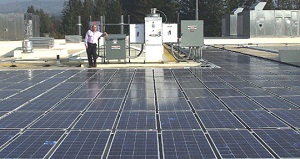California universities exceed goals for solar installations
 The California State University (CSU) system, which consists of 23 campuses throughout the golden state, is well on its way to installing a total of 50 megawatts of renewable energy generation on its campuses by the end of next year.
The California State University (CSU) system, which consists of 23 campuses throughout the golden state, is well on its way to installing a total of 50 megawatts of renewable energy generation on its campuses by the end of next year.
Nearly half, 22 megawatts, will consist of on-campus photovoltaic generation, according to CSU’s "The CSU Commitment to Sustainability: 2011 Report," issued April 15.
The university system already is exceeding the goal for solar generation set by its board of trustees, said spokesperson Erik Fallis.
“Right now, the goal set by the board of trustees had us going through 2014. We’re looking to exceed that goal two years early,” he said. “We’re going to have to look at a new goal because we’re exceeding our old target.”
The CSU Board of Trustees’ sustainability goals called for the statewide system to install 10 megawatts (MW) of solar power generation by 2014. But by the end of 2011, the system will have a total of at least 11.5 megawatts of solar installed across 18 of its 23 campuses. And under a partnership with the California Department of General Services, CSU could add another 11 megawatts by the end of 2012.
“If the installed and proposed systems continue to perform as the campuses have reported, we should see 36 million kWh [i.e., kilowatt hours] produced annually,” said Wesley Morgan, CSU’s Energy Program Manager. “This would be out of the 750 million kWh the CSU consumes in a year. This translates to approximately 5 percent of annual consumption being provided by solar.”
The school system also is pursuing renewable energy generation from other sources like cogeneration, wherein a natural gas-powered heating and cooling system is coupled with a waste-heat recovery generator that produces electricity by harvesting the waste-heat.
Together with cogeneration, CSU is already getting about 147 million kWh per year, or approximately 20 percent of CSU’s annual consumption from on-campus generation, according to Morgan.
While the higher-education school system has made better-than-expected progress on its renewable energy program, it’s lacking in some of its other sustainability efforts, like energy efficiency retrofitting, Fallis said.
“On the efficiency side, we do have room to improve. We hit about half of our goal,” he said. “We explained some of the reasons, like new energy intensive equipment.” But he said it’s also harder in the current environment to find funding for efficiency retrofits than it is to find funding for renewable energy projects or new construction.
To help address that issue, CSU has set its new building guidelines to exceed those set by the state.
All of California’s state-run higher-education organizations are partnering to work on sustainability issues, according to Fallis. That includes the University of California system, which has 10 campuses and the California Community Colleges system, which has 112 campuses throughout the state.
Image courtesy of Sonoma State University.



